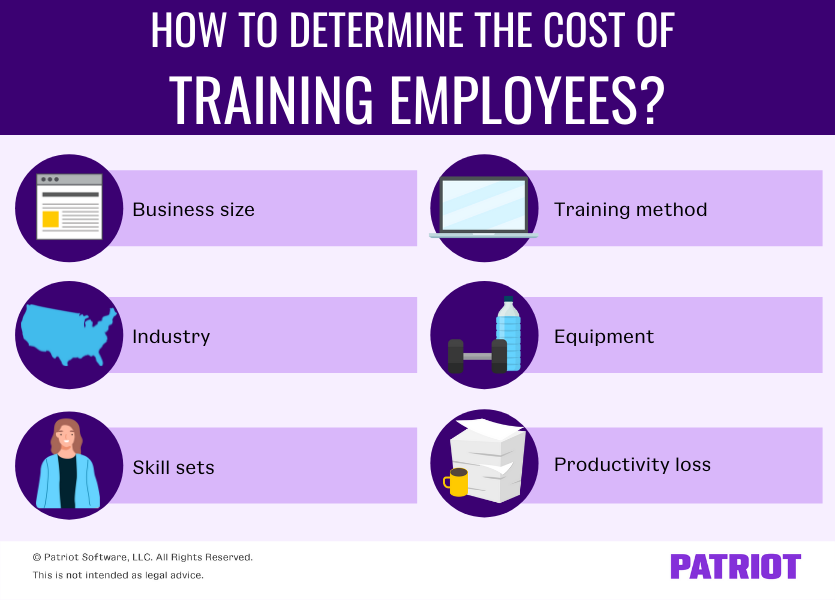Hiring new employees is a beautiful thing. Employees can simplify operations and bring in more money for your business. But before employees can be all-stars at your business, you must train them. What is the cost of training employees?
The cost of training employees
After spending time and money searching for top talent, you might not want to hear that the work isn’t over. But, training new employees is a necessary part of onboarding.
You must pour time and money into ensuring new hires understand their job responsibilities. Improper training can lead to sloppy work or eventual employee turnover, which means repeating the whole process.
The average training cost per employee is $1,252, according to the Association for Talent Development’s 2016 State of the Industry Report.
Money isn’t the only thing you will spend on training a new employee. You also need to put in your time. According to the ATD report, employers use an average of 33.5 training hours per employee.
Of course, the cost of training programs for employees won’t be the same for every business. Here are some factors that will determine the cost of training a new employee.

1. Business size
The size of your business has a big impact on how much you will spend on training. Employee training costs tend to be higher for small businesses than large corporations. On the other hand, large corporations spend more time training employees than smaller businesses.
Why does the cost of training staff vary between small and large businesses? Large companies might hire multiple employees at once, so training costs can be spread out between employees.
2. Industry
Business size isn’t the only factor that influences employee training costs. Your business industry also plays a role in costs.
The type of training new hires need varies from industry to industry. For example, training a receptionist is different than training a hazardous materials removal worker.
Some industries require extensive training. Specialized training for dangerous jobs is typically more expensive.
3. Skill sets
An employee’s skills will also determine training costs. Even if the employee meets or exceeds the required qualifications, other skills might be needed for the job.
Some employees will learn faster than others. No two employees work or learn at the same pace. Instead of overloading a struggling new hire with information, you might want to slow down. You may need to take more time and use more resources for some employees.
4. Training method
The type of training you provide impacts how much training will cost. What you use might depend on factors like your industry and the position. Here are just a few training methods:
- On-the-job training
- Classroom-style training
- Technology-based learning
- Simulations
With on-the-job training, employees learn by performing their actual jobs. This type of training encourages hands on learning, so employees might learn more quickly and jump into producing for the company.
Classroom-style training is a training method where you or another lecturer talks about the new hire’s job responsibilities. If you hire someone to teach employees, this will drive up the cost. You pass a lot of information onto the employee, which can be overwhelming and time-consuming.
Training new hires using technology, like computer or video programs, is known as technology-based learning. These training courses might be interactive. The more programs you purchase to teach employees, the more expensive the cost of training employees will be.
Simulations teach employees about the job by imitating real-life situations. This type of training can range from free to expensive, depending on the job.
5. Equipment
Depending on your chosen training method, you will need equipment and supplies. For example, technology-based learning requires computer programs and videos.
If employees keep their equipment (e.g., new work laptops), you won’t be able to reuse the materials in training future employees. You will need to buy new equipment each time you hire employees.
6. Productivity loss
When you train new employees or get your workforce involved, there is a loss in productivity. The time that could be spent on growing your business is instead spent on training the new hire. The cost of productivity loss will depend on how long your training program lasts.
You might decide to give your new hire a mentor. This could be an all-star employee at your business. Mentorship is effective for training employees, but it means your all-star employee will devote their time to training the new hire.
Let’s say you hire a new salesperson. You have your sales manager train the new hire for one week. Your sales manager typically brings in $5,000 per week. While they are training the new employee, your business could lose out on that $5,000.
How to calculate training cost per employee
If you want to determine how much training costs, keep accurate records of your expenses. Consider these costs:
- Training materials and equipment
- Loss of productivity (e.g., salaries paid during training)
- Payment for outside help (e.g., lecturers)
To find the cost of training employees for the year, add up all your training costs and divide by the number of new employees. You can do the same per month (training costs per month/number of new employees). This is the formula for calculating the training cost per employee:
Training Cost Per Employee = Total Training Expenses / Number of New Employees
For example, let’s say you spent $5,000 on training materials, $3,000 in lost productivity, and $2,000 on new laptops. You spent a total of $10,000 on training for the year. You hired 5 new employees. Your formula would look like this:
$10,000 / 5 = $2,000
You spent an average of $2,000 per employee.
Is the cost of training employees worth it?
Some business owners see the initial costs of training employees and panic. But, successfully training employees can save you money in the long run. Not only can successful training lead to more revenue for your business, it can also improve employee retention.
Improper training can lead to high employee turnover. One study found that 43.98% of employee turnovers take place within six months of starting at a business. Because training and onboarding take place for part or all of the first six months, you need to make sure your methods are effective.
Businesses spend an average of 21.4% of an employee’s salary on a replacement. So if an employee earning $40,000 leaves, you will spend a total of $8,560 replacing them (recruiting and hiring process, onboarding, and training). Help break up the cycle by taking the time to train employees diligently.
The more effort you put into making sure employees understand and are comfortable with their jobs, the less risk of employee turnover.
Managing employees can be stressful, but running payroll for them doesn’t have to be. Try Patriot Software’s payroll software. Or, opt for our payroll services, and let us remit and file your taxes for you!
This article has been updated from its original publication date of November 15, 2017.
This is not intended as legal advice; for more information, please click here.




